高中英语阅读课的教案
- 格式:docx
- 大小:14.65 KB
- 文档页数:7
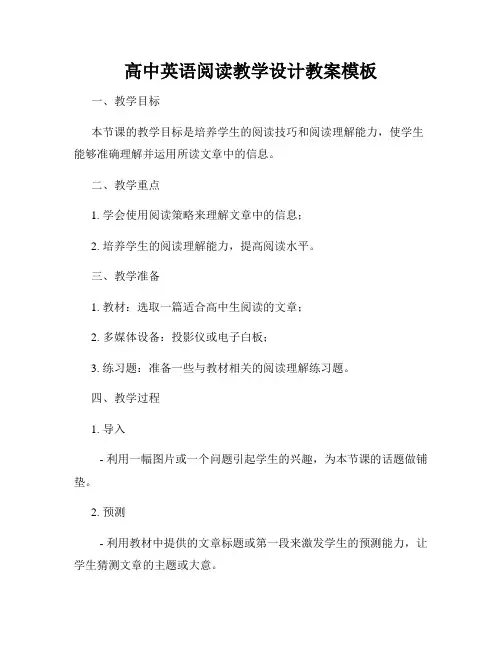
高中英语阅读教学设计教案模板一、教学目标本节课的教学目标是培养学生的阅读技巧和阅读理解能力,使学生能够准确理解并运用所读文章中的信息。
二、教学重点1. 学会使用阅读策略来理解文章中的信息;2. 培养学生的阅读理解能力,提高阅读水平。
三、教学准备1. 教材:选取一篇适合高中生阅读的文章;2. 多媒体设备:投影仪或电子白板;3. 练习题:准备一些与教材相关的阅读理解练习题。
四、教学过程1. 导入- 利用一幅图片或一个问题引起学生的兴趣,为本节课的话题做铺垫。
2. 预测- 利用教材中提供的文章标题或第一段来激发学生的预测能力,让学生猜测文章的主题或大意。
3. 阅读- 将文章分为若干段落,使用投影仪或电子白板展示文章,让学生带着问题阅读,并标记重要信息。
4. 讨论- 引导学生就文章中的问题进行讨论,激发学生的思考和表达能力。
5. 梳理- 将学生的讨论结果进行梳理,总结出文章的主要观点和重要细节。
6. 理解- 分发阅读理解练习题给学生,让学生根据文章内容进行解答,并检查答案。
7. 拓展- 给学生一篇类似主题的文章,让学生自主阅读并回答相关问题,以进一步拓展他们的阅读能力。
8. 归纳- 带领学生反思本节课的学习成果,总结阅读策略和技巧的应用方法。
五、课堂作业1. 要求学生根据教师提供的一篇中等难度的英语文章,自主进行阅读和理解,并以作文形式写出自己的观点和感想;2. 配置一些阅读理解练习题,要求学生完成并交给教师。
六、教学反思教师在此部分可以针对本节课的教学过程进行总结和反思,包括教学中出现的问题和学生的表现,以及对未来教学的改进建议。
以上是本节高中英语阅读教学设计教案模板,希望对您的教学设计有所帮助。
如有需要,您可以根据具体情况进行适当的调整和修改。
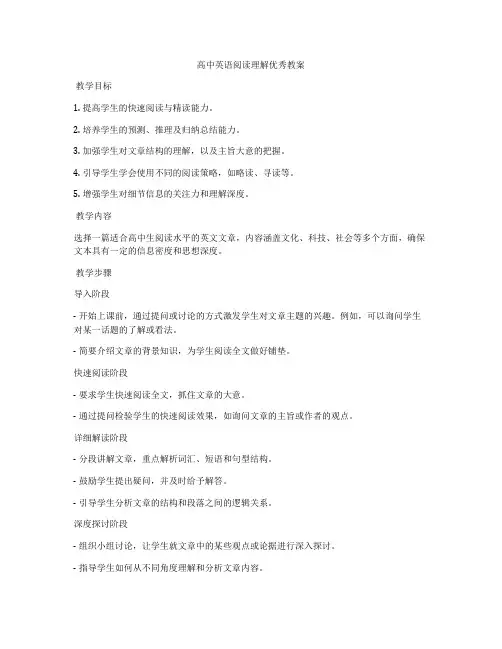
高中英语阅读理解优秀教案教学目标1. 提高学生的快速阅读与精读能力。
2. 培养学生的预测、推理及归纳总结能力。
3. 加强学生对文章结构的理解,以及主旨大意的把握。
4. 引导学生学会使用不同的阅读策略,如略读、寻读等。
5. 增强学生对细节信息的关注力和理解深度。
教学内容选择一篇适合高中生阅读水平的英文文章,内容涵盖文化、科技、社会等多个方面,确保文本具有一定的信息密度和思想深度。
教学步骤导入阶段- 开始上课前,通过提问或讨论的方式激发学生对文章主题的兴趣。
例如,可以询问学生对某一话题的了解或看法。
- 简要介绍文章的背景知识,为学生阅读全文做好铺垫。
快速阅读阶段- 要求学生快速阅读全文,抓住文章的大意。
- 通过提问检验学生的快速阅读效果,如询问文章的主旨或作者的观点。
详细解读阶段- 分段讲解文章,重点解析词汇、短语和句型结构。
- 鼓励学生提出疑问,并及时给予解答。
- 引导学生分析文章的结构和段落之间的逻辑关系。
深度探讨阶段- 组织小组讨论,让学生就文章中的某些观点或论据进行深入探讨。
- 指导学生如何从不同角度理解和分析文章内容。
策略训练阶段- 教授学生如何运用略读、寻读等阅读策略来寻找关键信息。
- 通过练习题让学生实践这些策略。
总结归纳阶段- 回顾全文,总结文章的主要内容和语言特点。
- 强调阅读理解中的关键技巧和方法。
作业布置- 布置相关的阅读理解练习题,以巩固课堂所学。
- 鼓励学生阅读额外的英文材料,提高自主学习能力。
教学反思- 课后,教师应根据学生的表现和反馈,对教学方法和内容进行调整。
- 分析哪些教学环节有效,哪些需要改进,以便在未来的教学中取得更好的效果。
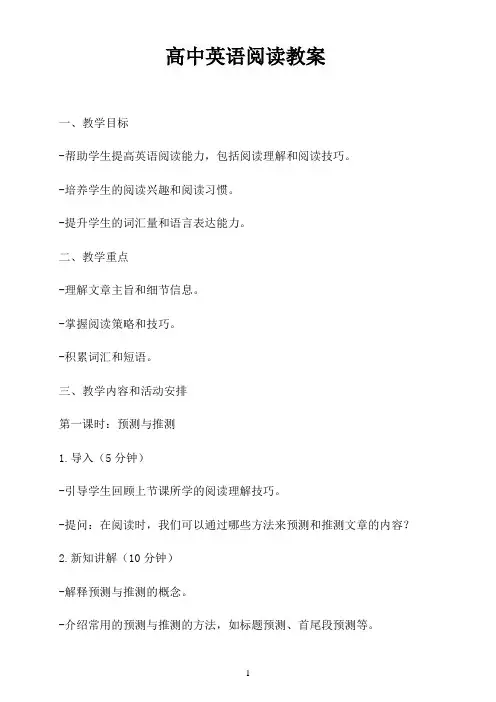
高中英语阅读教案一、教学目标-帮助学生提高英语阅读能力,包括阅读理解和阅读技巧。
-培养学生的阅读兴趣和阅读习惯。
-提升学生的词汇量和语言表达能力。
二、教学重点-理解文章主旨和细节信息。
-掌握阅读策略和技巧。
-积累词汇和短语。
三、教学内容和活动安排第一课时:预测与推测1.导入(5分钟)-引导学生回顾上节课所学的阅读理解技巧。
-提问:在阅读时,我们可以通过哪些方法来预测和推测文章的内容?2.新知讲解(10分钟)-解释预测与推测的概念。
-介绍常用的预测与推测的方法,如标题预测、首尾段预测等。
3.练习活动(15分钟)-分发一篇短文给学生,要求他们先阅读标题和首尾段,然后预测和推测文章的内容。
-学生互相讨论自己的预测和推测结果,并与实际文章内容进行比较。
4.小结归纳(5分钟)-引导学生总结本节课所学的预测与推测技巧和方法。
第二课时:主旨与细节1.导入(5分钟)-复习上节课所学的预测与推测技巧。
-提问:在阅读时,我们如何找到文章的主旨和细节信息?2.新知讲解(10分钟)-解释主旨与细节的概念。
-介绍查找主旨和细节信息的方法,如关键词标记、标题预测等。
3.练习活动(15分钟)-分发一篇短文给学生,要求他们阅读并回答相关问题,包括主旨和细节问题。
-学生互相交流自己的答案,并与文章内容进行比较。
4.小结归纳(5分钟)-引导学生总结本节课所学的查找主旨和细节信息的技巧和方法。
第三课时:词汇积累与理解1.导入(5分钟)-复习上节课所学的主旨与细节技巧。
-提问:在阅读时,我们如何理解生词并积累新词汇?2.新知讲解(10分钟)-介绍使用上下文推测词义的方法。
-引导学生注意词根、前缀和后缀等词形变化。
3.练习活动(15分钟)-分发一篇短文给学生,要求他们阅读并找出其中的生词。
-学生互相交流自己对生词的理解,并尝试推测其词义。
4.小结归纳(5分钟)-引导学生总结本节课所学的推测词义的方法和技巧。
四、教学资源和评估方式1.教学资源-阅读材料:包括文章、短文、新闻报道等,涵盖不同主题和难度。
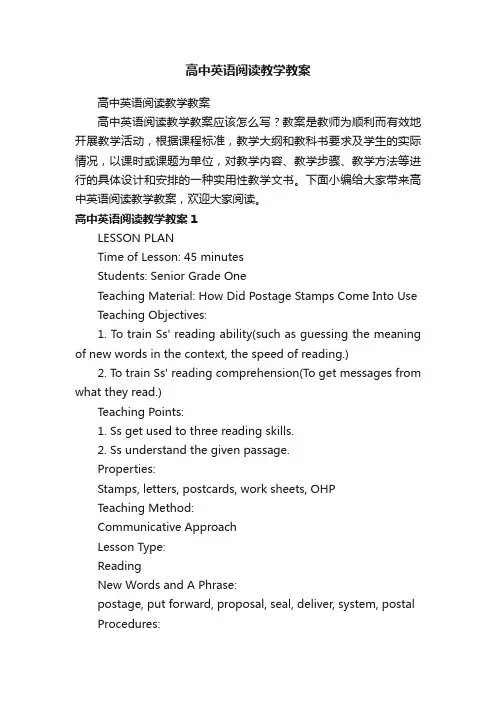
高中英语阅读教学教案高中英语阅读教学教案高中英语阅读教学教案应该怎么写?教案是教师为顺利而有效地开展教学活动,根据课程标准,教学大纲和教科书要求及学生的实际情况,以课时或课题为单位,对教学内容、教学步骤、教学方法等进行的具体设计和安排的一种实用性教学文书。
下面小编给大家带来高中英语阅读教学教案,欢迎大家阅读。
高中英语阅读教学教案1LESSON PLANTime of Lesson: 45 minutesStudents: Senior Grade OneTeaching Material: How Did Postage Stamps Come Into Use Teaching Objectives:1. To train Ss' reading ability(such as guessing the meaning of new words in the context, the speed of reading.)2. To train Ss' reading comprehension(To get messages from what they read.)Teaching Points:1. Ss get used to three reading skills.2. Ss understand the given passage.Properties:Stamps, letters, postcards, work sheets, OHPTeaching Method:Communicative ApproachLesson Type:ReadingNew Words and A Phrase:postage, put forward, proposal, seal, deliver, system, postal Procedures:Step 1. Warm-up(6')1. Lead-inShow some stamps, letters and postcards and have free talk to arouse students' motivation.2. Dealing with some new wordsQ: Do you know the postage of a letter?Explain "postage", and write postage on the Bb.postage: payment for the carrying of lettersA: Fifty fen for any place in China except Hong Kong, Taiwan and Macao.Q: What do the postmen do with the letters?A: They take the letters from the postbox and carry them away to the places on the envelopes and deliver them to the addressed people.Explain "deliver", and write deliver on the Bb.deliver: take letters or goods to the addressed people.Q: Who put forward the proposal to use stamps? Use OHP to project the question onto the screen.Explain "put forward" and "proposal", and write them on the Bb.put forward: put an idea before people for thinking overproposal: sth. proposed, plan or idea, suggestionAgain: Who put forward the proposal to use stamps?Step 2. Skimming(4'30")1. InstructionsT: Now I give you a passage to read, and for the first time you should only find the answer to the question. You have only two and a half minutes to read. So don't read word for word. Read quickly. Just try to find the answer.2. Handing out the reading material and readingQ: Who put forward the proposal to use stamps.A: Rowland Hill, a schoolmaster in England.Step 3. Scanning(6')1. InstructionsT: This time I give you three minutes to read the passage. When you are reading, find the answers to the two questions.Use OHP to project the questions:1. Why was the postage high in the early nineteenth century when people did not use stamps?2. When was postage stamps first put to use?2. Reading3. Checking1) Pair work2) Class checkingAns. to Que.1. Because the post offices had to send many people to collect the postage.Ans. to Que.2. On May 6, 1840.Step 4. Full reading(21')1. InstructionsT: Now I give you ten minutes to read the passage for the third time and you should read it carefully. Before reading, let's go over the questions on the work sheet.Give Work Sheet 1 to the Ss. Explain the new words in Que.4.prevent: stop, not let sb. do sth.reuse: use againT: Try to find the answers to the questions. But don't write the answers down, you can put a sign or underline the sentences concerning the questions.3. Checking1) Group work: Checking the answers in a group of four Ss.2) Class work: Checking the answers in class.Possible Answers:1. Why were people unhappy to pay postage for letters in the early nineteenth century?Because they had to pay postage when they received letters, especially when they paid for a letter which they did not wish to receive at all. The postage was high.2. Why was it much easier for people to use stamps for postage?Because people could go to the nearby post office to buy stamps and put them on envelopes before they sent the letters.3. Why was the postage much lower using stamps?Because in this way, the post office did not need to send postmen to collect postage. It only needed to send fewer postmen to deliver letters.4. How could the post office prevent people from reusing the stamps?The post office could simply put seals on the stamps so that people could not use the stamps again.Check the understanding of the word "seal", and write it on the Bb.seal: 邮戳5. Did other countries take up the new postal system?Yes.Check the understanding of "postal" and "system", and write them on the Bb.postal: of the postsystem: a set of working ways6. Does every country in the world has its own stamps?Yes.Step 5: Rounding-off(7')1. Answering Ss' questions on the passage if any.2. Making a guided-dialogue with the information given from the passage.Hand out Work Sheet 2. Do it in pairs.3. Asking two or three pairs to read their dailogues.A possible completed dialogue:A: Oh, What a beautiful stamp!B: Yes, it's from the U.S.A..A: Do you know in the early nineteenth century people did not use stamps?B: Then how did they pay the postage?A: They had to pay the postage when they received letters.B: Was the postage very high then?A: Yes. Because the post offices had to send many people to collect the postage.B: Who put forward the proposal to use stamps?A: Rowland Hill, a schoolmaster in England.B: Why do post offices put seals on the stamps?A: They can prevent people from using the stamps again.B: When did post offices begin to sell stamps?A: On May 6, 1840.B: Thank you for telling me so many things about stamps.Step 6. Assignment(30")Ask the Ss to shorten the passage within four or five sentences after class, and to write it in their exercise books.*************************************************************Reading Material:How Did Postage Stamps Come Into UseWhen you send a letter or a postcard, you have to put stamps on the envelope or on the card. When did people first begin to use stamps? Who was the first to think of this idea?In the early nineteenth century, people did not use stamps. They had to pay postage when they received letters. They were unhappy about this, especially when they paid for a letter which they did not wish to receive at all. The postage was high at that time, because the post offices had to send many people to collect the postage.Rowland Hill, a schoolmaster in England, was the first to put forward a proposal to use stamps. He thought it would be much easier for people to use stamps to cover postage. They could go to the nearby post office to buy stamps and put them on envelopes before they sent the letters. The post office could simply put seals on the stamps so that people could not use the stamps again. In this way, the post office did not need to send postmen to collect postage. It only needed to send fewer postmen to deliver letters. That was a good idea and the government finally accepted it.On May 6, 1840, post offices throughout England began to sell stamps. Soon this new postal system was taken up by other countries. Now each country has its own stamps. And there are many people who collect stamps all over the world.Work Sheet 1:Find the answers to the following questions from the passage:1. Why were people unhappy to pay postage for letters in the early nineteenth century?2. Why was it much easier for people to use stamps for postage?3. Why was the postage much lower using stamps?4. How could the post office prevent people from reusing the stamps?5. Did other countries take up the new postal system?6. Does every country in the world has its own stamps now?Work Sheet 2:Complete the dialogue with the information you have got: A: Oh, What a beautiful stamp!B: Yes, it's from the U.S.A..A: Do you know ____________________ people did not use stamps?B: Then how did they pay the postage?A: ___________________________________________________________.B: Was the postage very high then?A: ___________________________________________________________.B: Who put forward the proposal to use stamps?A: ___________________________________________________________.B: Why do post offices put seals on the stamps?A: ___________________________________________________________.B: When did post offices begin to sell stamps?A: ___________________________________________________________.B: Thank you for telling me so many things about stamps. 高中英语阅读教学教案2Module 7 Unit 4 SharingReading A Letter HomeⅠ.Teaching ContentsModule 7 Unit4 Sharing Reading: A Letter HomeII.Analysis of teaching material本单元的话题是Sharing,本课设计的这篇课文是一个志愿者的一封家书,她在巴布亚新几内亚共和国的一个小山村教书。
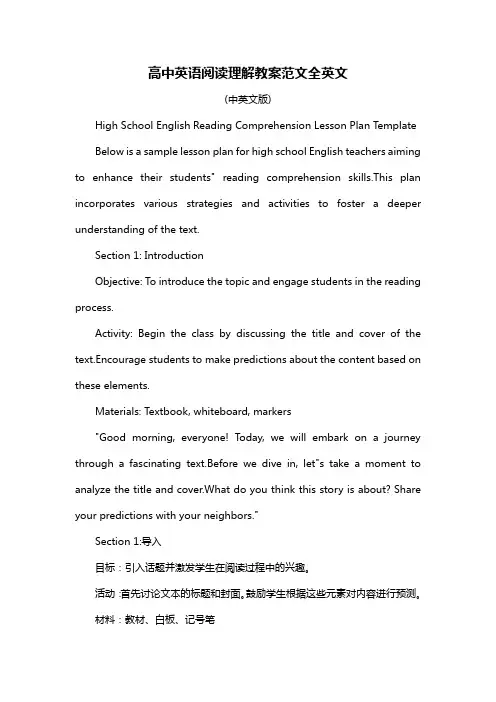
高中英语阅读理解教案范文全英文(中英文版)High School English Reading Comprehension Lesson Plan Template Below is a sample lesson plan for high school English teachers aiming to enhance their students" reading comprehension skills.This plan incorporates various strategies and activities to foster a deeper understanding of the text.Section 1: IntroductionObjective: To introduce the topic and engage students in the reading process.Activity: Begin the class by discussing the title and cover of the text.Encourage students to make predictions about the content based on these elements.Materials: Textbook, whiteboard, markers"Good morning, everyone! Today, we will embark on a journey through a fascinating text.Before we dive in, let"s take a moment to analyze the title and cover.What do you think this story is about? Share your predictions with your neighbors."Section 1:导入目标:引入话题并激发学生在阅读过程中的兴趣。

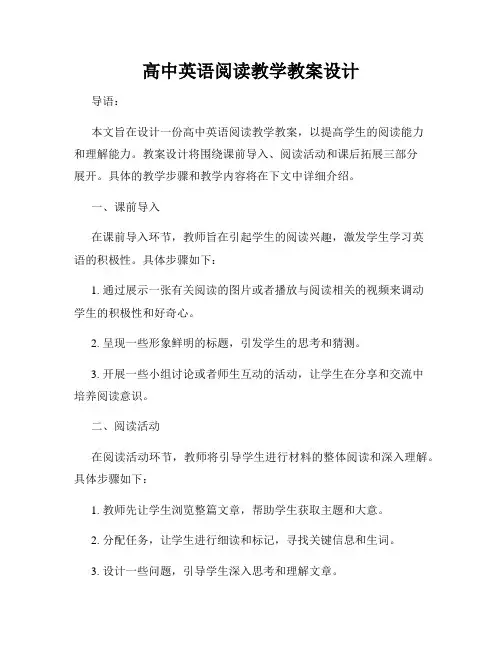
高中英语阅读教学教案设计导语:本文旨在设计一份高中英语阅读教学教案,以提高学生的阅读能力和理解能力。
教案设计将围绕课前导入、阅读活动和课后拓展三部分展开。
具体的教学步骤和教学内容将在下文中详细介绍。
一、课前导入在课前导入环节,教师旨在引起学生的阅读兴趣,激发学生学习英语的积极性。
具体步骤如下:1. 通过展示一张有关阅读的图片或者播放与阅读相关的视频来调动学生的积极性和好奇心。
2. 呈现一些形象鲜明的标题,引发学生的思考和猜测。
3. 开展一些小组讨论或者师生互动的活动,让学生在分享和交流中培养阅读意识。
二、阅读活动在阅读活动环节,教师将引导学生进行材料的整体阅读和深入理解。
具体步骤如下:1. 教师先让学生浏览整篇文章,帮助学生获取主题和大意。
2. 分配任务,让学生进行细读和标记,寻找关键信息和生词。
3. 设计一些问题,引导学生深入思考和理解文章。
4. 帮助学生掌握阅读策略,如扫读、略读和精读。
5. 引导学生进行词汇和语法的分析,培养学生的语言运用能力。
三、课后拓展在课后拓展环节,教师将组织学生进行一些拓展活动,以促进学生在阅读中的自主学习和思考。
具体步骤如下:1. 布置一些与文章内容相关的作业,如写一篇小短文、设计一个续写、形成自己的问题等,以检验学生对文章的理解和运用能力。
2. 推荐一些相关的阅读材料,鼓励学生拓宽阅读视野。
3. 鼓励学生与同学分享自己的阅读心得和体会,培养合作学习的氛围。
结语:通过本节课的阅读教学活动,学生应该能够提高他们的阅读能力和理解能力,同时也能培养他们的自主学习和合作学习的能力。
希望通过本教案设计,能够为高中英语阅读教学提供一种有效的教学参考。
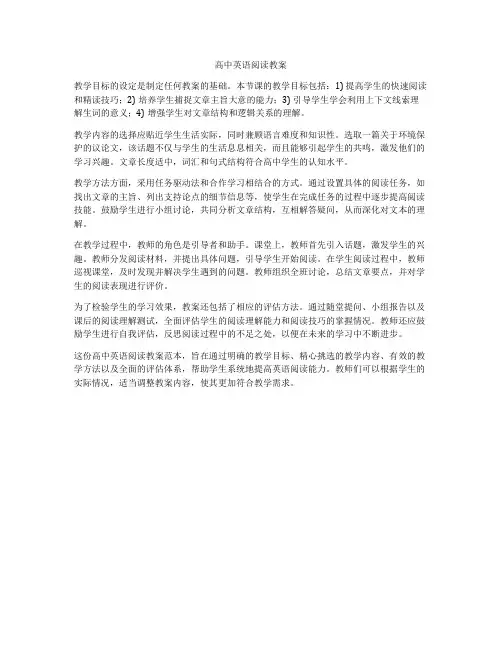
高中英语阅读教案教学目标的设定是制定任何教案的基础。
本节课的教学目标包括:1) 提高学生的快速阅读和精读技巧;2) 培养学生捕捉文章主旨大意的能力;3) 引导学生学会利用上下文线索理解生词的意义;4) 增强学生对文章结构和逻辑关系的理解。
教学内容的选择应贴近学生生活实际,同时兼顾语言难度和知识性。
选取一篇关于环境保护的议论文,该话题不仅与学生的生活息息相关,而且能够引起学生的共鸣,激发他们的学习兴趣。
文章长度适中,词汇和句式结构符合高中学生的认知水平。
教学方法方面,采用任务驱动法和合作学习相结合的方式。
通过设置具体的阅读任务,如找出文章的主旨、列出支持论点的细节信息等,使学生在完成任务的过程中逐步提高阅读技能。
鼓励学生进行小组讨论,共同分析文章结构,互相解答疑问,从而深化对文本的理解。
在教学过程中,教师的角色是引导者和助手。
课堂上,教师首先引入话题,激发学生的兴趣。
教师分发阅读材料,并提出具体问题,引导学生开始阅读。
在学生阅读过程中,教师巡视课堂,及时发现并解决学生遇到的问题。
教师组织全班讨论,总结文章要点,并对学生的阅读表现进行评价。
为了检验学生的学习效果,教案还包括了相应的评估方法。
通过随堂提问、小组报告以及课后的阅读理解测试,全面评估学生的阅读理解能力和阅读技巧的掌握情况。
教师还应鼓励学生进行自我评估,反思阅读过程中的不足之处,以便在未来的学习中不断进步。
这份高中英语阅读教案范本,旨在通过明确的教学目标、精心挑选的教学内容、有效的教学方法以及全面的评估体系,帮助学生系统地提高英语阅读能力。
教师们可以根据学生的实际情况,适当调整教案内容,使其更加符合教学需求。
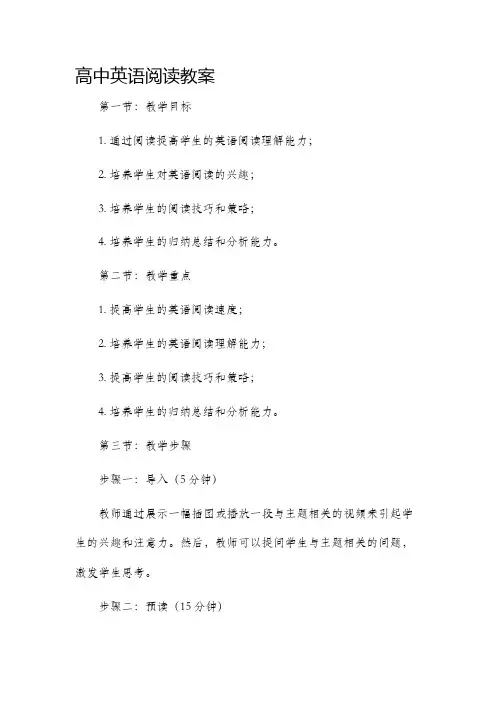
高中英语阅读教案第一节:教学目标1. 通过阅读提高学生的英语阅读理解能力;2. 培养学生对英语阅读的兴趣;3. 培养学生的阅读技巧和策略;4. 培养学生的归纳总结和分析能力。
第二节:教学重点1. 提高学生的英语阅读速度;2. 培养学生的英语阅读理解能力;3. 提高学生的阅读技巧和策略;4. 培养学生的归纳总结和分析能力。
第三节:教学步骤步骤一:导入(5分钟)教师通过展示一幅插图或播放一段与主题相关的视频来引起学生的兴趣和注意力。
然后,教师可以提问学生与主题相关的问题,激发学生思考。
步骤二:预读(15分钟)教师为学生分发一篇阅读材料,并简要介绍文章的背景和主要内容。
然后,教师可以让学生浏览文章的标题、题图、图表等,预测文章的内容和结构。
学生可以在文本中划出重点词汇,并进行相关的背景知识补充。
步骤三:阅读(30分钟)学生开始阅读文章,可以根据自己的阅读能力和速度自主选择阅读方式,可以整篇阅读,也可以分段阅读。
学生要尽量将重要信息标注出来,例如关键词、关键句等。
阅读过程中,教师可以给予学生一些指导,帮助他们理解文本。
步骤四:讨论与总结(20分钟)教师可以提出一些问题,让学生进行讨论和思考。
例如,对于文章中的某个观点或事件,学生可以就其利弊、原因、影响等进行讨论。
然后,教师可以引导学生进行总结和归纳,梳理出文章的主要内容和观点。
学生可以用自己的话对文章进行复述。
步骤五:拓展(10分钟)教师可以提供一些相关的拓展材料,例如其他相关的阅读材料、音频或视频等,以帮助学生深入了解和拓展所学内容。
学生可以选择进行自主阅读,然后进行小组或全班分享。
第四节:教学方法1. 预测法:通过浏览文章的标题、问题或题图等元素,预测文章的内容和结构,提前激发学生对文章的兴趣和好奇心。
2. 标注法:学生在阅读过程中可以使用不同的标记方式来标注关键词、信息和观点,有助于加强记忆和理解。
3. 讨论法:通过小组或全班讨论的方式,让学生积极参与,提出自己的观点和思考,加深对文章的理解。
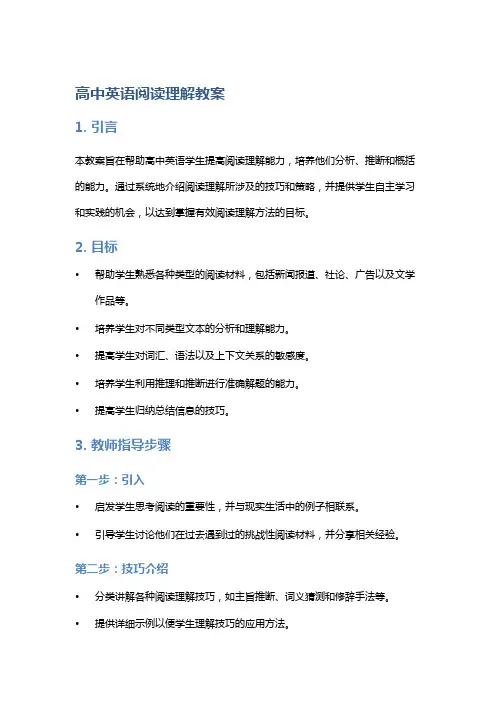
高中英语阅读理解教案1. 引言本教案旨在帮助高中英语学生提高阅读理解能力,培养他们分析、推断和概括的能力。
通过系统地介绍阅读理解所涉及的技巧和策略,并提供学生自主学习和实践的机会,以达到掌握有效阅读理解方法的目标。
2. 目标•帮助学生熟悉各种类型的阅读材料,包括新闻报道、社论、广告以及文学作品等。
•培养学生对不同类型文本的分析和理解能力。
•提高学生对词汇、语法以及上下文关系的敏感度。
•培养学生利用推理和推断进行准确解题的能力。
•提高学生归纳总结信息的技巧。
3. 教师指导步骤第一步:引入•启发学生思考阅读的重要性,并与现实生活中的例子相联系。
•引导学生讨论他们在过去遇到过的挑战性阅读材料,并分享相关经验。
第二步:技巧介绍•分类讲解各种阅读理解技巧,如主旨推断、词义猜测和修辞手法等。
•提供详细示例以便学生理解技巧的应用方法。
第三步:阅读练习•提供多个不同类型的阅读材料。
•学生独立或合作阅读,并使用所学技巧进行分析和解题。
•教师提供指导和反馈。
第四步:讨论与分享•鼓励学生分享他们的答案和解题思路。
•引导学生互相评价和纠正,加深对阅读理解技巧的理解。
第五步:总结与检验•总结本节课所学的关键技巧和策略,并逐一复习。
•进行一次小测验,以评估学生对课堂内容的掌握情况。
4. 学生自主活动建议为了巩固所学知识并培养良好的阅读习惯,教师可以鼓励学生在家中开展以下活动:•每天坚持阅读英语资料,包括新闻文章、综合材料等。
•自主选取许多不同类型的文章,并使用所学技巧进行分析和总结.•建立词汇和短语的卡片,用于记忆和巩固。
5. 教学评估与反思根据学生的表现和活动情况,教师可以进行以下评估与反思:•学生的阅读理解能力是否有所提高?是否能有效应用所学技巧?•学生通过自主活动是否积极参与,并在实践中不断提升自己的能力?•教案设计是否足够清晰和具体,对学生进行个性化指导?是否需要进行进一步改进?总结通过本教案,我们旨在帮助学生掌握高中英语阅读理解技巧和策略。
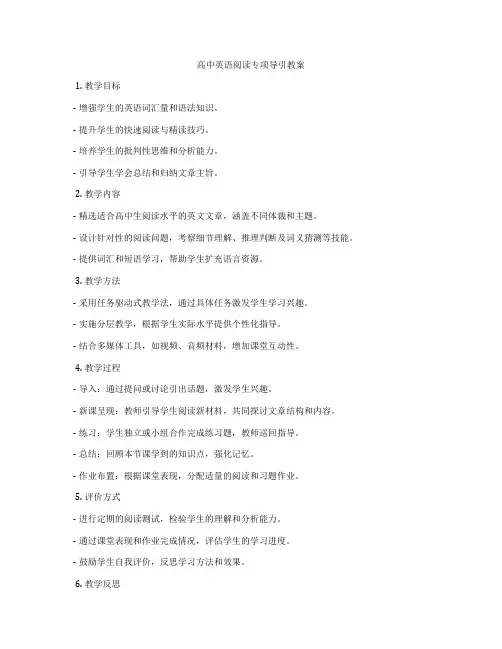
高中英语阅读专项导引教案
1. 教学目标
- 增强学生的英语词汇量和语法知识。
- 提升学生的快速阅读与精读技巧。
- 培养学生的批判性思维和分析能力。
- 引导学生学会总结和归纳文章主旨。
2. 教学内容
- 精选适合高中生阅读水平的英文文章,涵盖不同体裁和主题。
- 设计针对性的阅读问题,考察细节理解、推理判断及词义猜测等技能。
- 提供词汇和短语学习,帮助学生扩充语言资源。
3. 教学方法
- 采用任务驱动式教学法,通过具体任务激发学生学习兴趣。
- 实施分层教学,根据学生实际水平提供个性化指导。
- 结合多媒体工具,如视频、音频材料,增加课堂互动性。
4. 教学过程
- 导入:通过提问或讨论引出话题,激发学生兴趣。
- 新课呈现:教师引导学生阅读新材料,共同探讨文章结构和内容。
- 练习:学生独立或小组合作完成练习题,教师巡回指导。
- 总结:回顾本节课学到的知识点,强化记忆。
- 作业布置:根据课堂表现,分配适量的阅读和习题作业。
5. 评价方式
- 进行定期的阅读测试,检验学生的理解和分析能力。
- 通过课堂表现和作业完成情况,评估学生的学习进度。
- 鼓励学生自我评价,反思学习方法和效果。
6. 教学反思
- 教师需不断更新教学材料,确保内容的时效性和相关性。
- 关注学生的个体差异,调整教学策略以满足不同需求。
- 定期收集学生反馈,优化教学方法和过程。
7. 结语。
高中英语阅读理解教案教学目标:1. 学生能够理解文章主旨大意。
2. 学生能够分析作者的观点和论据。
3. 学生能够掌握并运用文章中的关键词汇和短语。
4. 学生能够通过阅读提高推理和判断能力。
5. 学生能够培养批判性思维和自主学习的能力。
教学内容:选取一篇适合高中生阅读水平的英文文章,内容应涵盖社会、文化、科技等多个方面,以增加学生的阅读兴趣和知识面。
教学步骤:1. 预习导入:在课堂开始前,布置预习任务,要求学生独立阅读课文,标记不懂的单词和句子,准备分享自己的理解和疑问。
2. 导入新课:通过提问或讨论的方式,了解学生的预习情况,激发学生对文章内容的兴趣。
可以提出一些开放性问题,如:“你认为这篇文章的主题是什么?”“你对文章中哪个观点印象深刻?”等。
3. 详细解读:教师带领学生逐段分析文章,解释生词和难句,确保学生对文章内容有清晰的理解。
同时,教师应注重培养学生的推理能力,鼓励学生根据文章内容进行合理推断。
4. 重点突出:针对文章中的关键段落或难点,进行深入讲解。
教师可以设计一些问题,引导学生思考作者的写作目的、观点和论据,以及这些如何支撑文章的主题。
5. 练习巩固:提供一些与文章内容相关的练习题,如选择题、填空题、简答题等,帮助学生巩固所学知识点。
可以让学生进行小组讨论,分享彼此的理解和答案,以此提高他们的合作能力和口语表达能力。
6. 拓展提升:为了培养学生的批判性思维,教师可以提出一些挑战性的问题,如:“你同意作者的观点吗?为什么?”“如果你是作者,会如何论证你的观点?”等。
这些问题可以促使学生从不同角度思考问题,提高他们的分析和判断能力。
7. 作业布置:布置适当的家庭作业,如写一篇关于文章主题的短文,或者寻找与文章主题相关的额外阅读材料,以加强学生的自主学习能力。
8. 反馈总结:在下一节课上,教师应该对学生的作业进行点评,总结本次课程的学习成果,并对学生的学习表现给予积极的反馈。
高中英语阅读理解教案一、教学目标1.培养学生的阅读理解能力,特别是对英语文章的理解和分析能力;2.提高学生的阅读速度,培养快速获取信息的能力;3.帮助学生掌握阅读策略,如预测、推断、概括等;4.培养学生的独立思考和解决问题的能力。
二、教学重点1.学习并掌握不同类型的阅读理解题型;2.培养学生的阅读策略,提高解题效率;3.帮助学生分析和理解英语文章的逻辑结构。
三、教学内容1. 阅读理解题型1.主旨理解题:要求学生从文章中找出主要观点或主题;2.细节理解题:要求学生根据文章中的具体细节回答问题;3.推理判断题:要求学生根据已有信息进行推理判断;4.词义推测题:要求学生根据上下文推测生词或短语的意思;5.篇章结构题:要求学生理解文章的整体结构。
2. 阅读策略1.预测:学生在阅读前先猜测文章的主题、内容和结构,培养对文章的整体把握能力;2.分段阅读:学生按照文章的段落结构进行阅读,理解每一段的主题和细节,提高阅读的效率;3.词汇猜测:学生通过上下文猜测生词的意思,培养运用语境推测词义的能力;4.概括总结:学生在阅读完一篇文章后,对文章的主旨、观点和结构进行总结和概括,提高对文章的整体理解能力。
3. 阅读策略训练1.给学生提供一篇适合高中英语水平的短文,并设置不同类型的阅读理解题目;2.引导学生先预测文章的主题和结构,并提醒学生在阅读过程中注意细节;3.学生独立进行阅读训练,按照不同题型进行解题;4.辅导学生如何运用阅读策略解题,鼓励学生进行推理和概括;5.检查学生的解题情况,及时给予反馈和指导。
4. 拓展活动1.学生进行小组讨论,对一篇较长的阅读材料进行综合理解和分析;2.学生选取自己感兴趣的文章,利用所学的阅读策略进行独立阅读和理解;3.学生结合已学的语法知识和词汇积累,尝试进行英语文章的写作。
四、教学方法1.情境教学法:通过设置具体的阅读情境,激发学生的学习兴趣和阅读动力;2.合作学习法:通过小组讨论和合作解题,培养学生的合作意识和团队精神;3.演示讲解法:教师针对不同阅读理解题型进行讲解和示范,帮助学生理解题目要求和解题思路;4.实践教学法:学生通过大量的阅读练习和解题训练,巩固所学的阅读理解技巧和策略。
英语课教案二:高中阅读理解练习一、背景和目标在高中英语教学中,阅读理解是非常重要的一项内容。
因为英语阅读已经成为我们生活和工作中不可缺少的一部分,所以教师需要通过阅读理解练习,帮助学生提高语阅读叙事、议论和说明型文章的能力。
二、教学过程1.开始前引导学生主动思考和猜测文章标题,以此激发学生的兴趣和好奇心。
然后给出一些关键词,激活学生的相关经验知识。
2.阅读和理解学生进入阅读环节。
在这一环节中,学生可以自主阅读,教师也可以提供语言点和课文理解帮助学生理解文章。
3.理解和解决问题此环节是阅读理解的重点。
教师可以设置一些问题,引导学生理解文章,并解答问题,检查学生的阅读理解能力。
问题设置应注意:既要简单,又要贫困,有助于学生回溯文中答案的信息。
此外,问题解答的过程可以为学生提供文章信息的预演和掌握方法。
4.总结和反思学生完成了问题解答后,教师可以进行回顾和总结。
让学生将文中易犯的错误、易混淆的语言点、对问题理解不够彻底的问题等总结出来。
教师要引导学生彻底理解文章,找出其中的深层次信息,并整合文章中的语言知识。
三、教学策略与技巧1.激活学习者的知识和经验先探讨一些对文章内容有所帮助的关键词或词汇,可以涵盖学生的生活经验和知识体系。
2.提供语言学习机会在教学过程中,要将语言点与文章联系起来,让学生具有实践性。
例如,可以针对阅读理解所使用的句型或语言点进行练习。
3.指导学生处理海量信息学生在阅读理解过程中会受到文本内容、语言信息、题目要求等多方面的影响,要指导学生掌握信息的处理方法,循序渐进地进行阅读理解。
4.鼓励阅读,促进思考阅读有助于学生积累语言知识,但是,阅读不仅仅是为了积累语言知识,还可以在不断地阅读和思考中提高学生的加工语言信息和解决问题的能力。
四、注意事项1.适当引导学生在阅读理解过程中,教师应适当引导学生,让学生更好地理解文章。
例如,指导学生发现文本中的联词,帮助学生构建文本的逻辑关系。
2.在某种程度上解释文本在阅读理解中,教师应根据学生的情况,选取一些组织性或语言性较难的问题,给与更细致的解释,引导学生更好地理解文章。
高中英语阅读教学教案第一章:阅读理解的重要性1.1 教学目标让学生理解阅读理解在英语学习中的重要性。
培养学生对英语阅读的兴趣和自信心。
1.2 教学内容阅读理解的概念和定义。
阅读理解在英语学习中的作用。
培养学生阅读理解的策略和技巧。
1.3 教学方法讲授法:讲解阅读理解的概念和定义,引导学生思考阅读理解的重要性。
互动讨论法:分组讨论,分享个人经验,探讨阅读理解在英语学习中的作用。
1.4 教学评估小组讨论:评估学生的参与度和思考能力。
学生报告:评估学生的表达和沟通能力。
第二章:阅读理解的策略和技巧2.1 教学目标让学生掌握阅读理解的策略和技巧。
培养学生运用策略和技巧进行有效阅读。
2.2 教学内容阅读理解的策略和技巧,如预测、扫描、略读、细读等。
练习运用策略和技巧进行阅读理解。
2.3 教学方法讲授法:讲解阅读理解的策略和技巧,引导学生思考如何运用。
实践法:学生进行阅读练习,教师指导并提供反馈。
2.4 教学评估阅读练习:评估学生的理解和运用能力。
教师反馈:评估学生的进步和需要改进的地方。
第三章:词汇理解3.1 教学目标让学生理解词汇在阅读理解中的重要性。
培养学生词汇理解和扩展的能力。
3.2 教学内容词汇理解的概念和定义。
词汇扩展的策略和方法,如使用词典、上下文推断等。
3.3 教学方法讲授法:讲解词汇理解的概念和定义,引导学生思考词汇在阅读理解中的作用。
互动讨论法:分组讨论,分享个人经验,探讨词汇扩展的策略和方法。
3.4 教学评估小组讨论:评估学生的参与度和思考能力。
学生报告:评估学生的表达和沟通能力。
第四章:阅读理解的实践4.1 教学目标让学生运用所学的阅读理解策略和技巧进行实践。
培养学生的阅读理解能力和综合运用能力。
4.2 教学内容提供不同类型的阅读材料,如故事、文章、报告等。
学生独立进行阅读理解实践。
4.3 教学方法实践法:学生进行阅读理解实践,教师指导并提供反馈。
分组讨论法:学生分组讨论,分享阅读理解的心得和体会。
教师资格证考试-面试-高中英语-教案模板+逐字稿-阅读课一、教学目标1. 知识目标:让学生掌握阅读技巧,提高阅读理解能力。
2. 能力目标:培养学生具备快速阅读、推理判断、词义猜测等阅读能力。
3. 情感目标:二、教学内容1. 教材:《高中英语阅读课教材》2. 主题:人与自然的关系3. 文章:《The Environment and Our Future》三、教学过程1. 导入:利用图片或实物引导学生谈论人与自然的关系,引出本课主题。
2. 自主阅读:让学生独立阅读文章,了解文章大意,培养学生快速阅读的能力。
3. 检查理解:通过问答方式检查学生对文章的理解程度,帮助学生巩固所学内容。
4. 深入讨论:引导学生针对文章内容进行深入讨论,提高学生的思维能力和表达能力。
5. 总结提升:总结文章主题,引导学生思考人与自然的关系,提出保护环境的建议。
四、教学评价1. 课堂表现:观察学生在课堂上的参与程度、发言情况等,评价学生的积极性。
2. 阅读理解:通过问答、讨论等方式检查学生的阅读理解能力,评价学生的学习效果。
3. 课后作业:布置相关阅读任务,要求学生课后完成,以巩固所学内容。
五、教学资源1. 教材:《高中英语阅读课教材》2. 图片或实物:用于导入和激发学生兴趣3. 多媒体设备:用于展示文章、播放相关视频等六、教学建议1. 注重培养学生的主体性,鼓励学生积极参与课堂活动。
2. 注重阅读技巧的培养,引导学生运用推理判断、词义猜测等方法提高阅读理解能力。
3. 注重情感教育,引导学生关注人与自然的关系,培养环保意识。
4. 课后加强辅导,针对学生的薄弱环节进行有针对性的教学。
六、教学重点与难点重点:1. 掌握文章的主要内容和观点。
2. 运用阅读技巧提高阅读理解能力。
难点:1. 理解和运用文章中的重点词汇和短语。
2. 分析和推理文章中的隐含意义。
七、教学方法1. 任务型教学法:通过完成各种任务,激发学生的学习兴趣和积极性。
高中英语阅读课教学案例全文共四篇示例,供读者参考第一篇示例:标题:高中英语阅读课教学案例引言:阅读是学习英语的重要环节,通过阅读,学生可以扩展词汇量,增进对语言结构和语法的理解,培养阅读理解能力和思维能力。
为了提高高中学生的英语阅读水平,教师需要精心设计教学案例,引导学生进行深入的阅读教学活动。
本文将通过一个具体的教学案例,探讨高中英语阅读课的教学设计和实施过程,旨在为英语教师提供一些教学参考。
一、教学目标1. 能够理解文本的主旨和要点。
2. 能够根据上下文推测词义。
3. 能够从文中获取信息,提炼信息。
4. 能够进行文本分析,提高阅读理解能力。
5. 能够在阅读中培养对文化和社会问题的认识和思考能力。
二、教学内容所选择的教学内容为一篇关于环保的短文。
内容包括环境问题的描述、环保意识的培养和环境保护的重要性等。
三、教学方法1.多媒体教学法:通过图片、视频等多媒体资料引导学生了解环保问题,激发学生的学习兴趣。
2.启发式教学法:通过提出问题、展示情景等方式引导学生主动思考、发现问题、寻找解决问题的方法。
3.合作学习法:设计小组讨论、合作阅读等活动,让学生在合作中相互学习、思考,激发学生的学习热情。
四、教学过程1.课前导入2.课堂授课以小组活动的形式展示短文内容,让学生对环保问题有一个整体的认识。
然后,教师可以选择一些重点段落进行讲解,重点讲解一些语言点,并进行相关词汇的讲解和拓展。
3.合作学习通过小组讨论、合作阅读等活动,让学生在合作中相互学习、思考,提高阅读理解能力。
学生可以在小组中相互交流想法,共同解决阅读中遇到的问题,增强对环保问题的理解和认识。
4.课堂总结教师对本节课的内容进行总结,鼓励学生对所学知识进行总结和提炼。
可以通过提问、讨论等方式激发学生对环保问题的思考和探索。
五、教学评价教学过程中,教师可以通过观察学生的表现和小组讨论的情况等来对学生的阅读理解能力和综合能力进行评价。
可以设计一些阅读理解题目、课堂问题等进行及时的检测。
高中英语阅读课的教案【篇一:高中英语阅读课教学案例】teaching procedures教学过程设计step1 warming upt: boys and girls, good morning. are you in a good mood today? s: yes!t: i’m so happy to hear that. what kinds of words can be usedto describe the persons’ emotions.ss: (lost in thought)t:let’s enjoy some pictures and find out some emotional words to describe them. ss: (very interested and excited)t:go through the following words and match them with the correct meaningemotionangrycross a feeling that you experiencefrustration a feeling when you are prevented from doingwhat you wantcuriosityto make something less difficultsimplify (vt.) a strong feeling of wanting to find out about something 设计意图:以阅读材料为依托,在单词教学环节向学生渗透语篇意识,引导学生在语境中理解单词、短语的意义以及用法。
在具体的教学中,采用了单词与词义配对、构词法练习,图文并茂猜。
t: would you like to think of some emotional words which canfit the situation. situation 1:this morning when i got to school, my headmaster asked meto her office. she told me i was the only student who hadpassed the exam and would have a chance to be an exchange student.s1: happiness/excitementsituation 2:however, about half an hour later, i was called to the office again and was told that the teacher had made a mistake!s2:disappointment/frustrationt:where can we find happiness in our life? are they really happy? (more pictures for the students to glance through)ss: (heated discussion)t: i can’t agree more. such pictures do bring us so muchsimple happiness. to have happiness is just so easy.设计意图:从学生的实际出发引导、激发学生的学习兴趣和探究热情,引起学生情感上的共鸣,并自然地导入下一个活动任务。
step2: lead-int: we can find happiness in all respect in our daily life. whatcan bring people happiness? do you think there are somethings that make everyone happy? what are they? can you guess?ss: (very interested and excited)suggested answers:s1:s2s3s4s5t: good answers! 设计意图:通过向学生们展示许多贴近生活实际的图片,调动学生的求知欲,培养学生积极参与课堂活动的意识。
同时设计一些与阅读文章有关联的问题,为下一步的教学活动做铺垫。
step3:read for informationt: nice going! you know, miss dinsmore was annoyed with her little gray house. do you want to know what can make miss dinsmore happy? let’s read the passage and try to fill in the chart with information from the reading material.how to make her house more cheerful,she understood it was really cheerful to share happiness with others.设计意图:训练学生快速略读的阅读技巧,了解文章的大意和主旨,对所读材料的体裁、结构和逻辑关系有一定了解,舍弃文章细节及一切无关紧要内容,培养学生的逻辑推理和判断能力。
step4: read for comprehensiont: we’ve got a general idea about the passage. should we try to know more information? let’s read the story more caref ully and find out the answers to the following questions:1.can you find a word in the passage with the same meaningof “cheerful”?2.how did she do to choose the best cheerful house?3.what puzzled her most with the so many pictures?4.what did the news refer to?5.what can be inferred from the underlined part?ss: (in silence) different answers:s1:nices2:she painted picture after picture.s3:she still couldn’t decide which colour would make her house look as cheerful as cheerful can be.s4:dinsmore painted very well.s5:the secret to happiness is to share it with others.s6:true happiness comes from the mind /as cheerful as cheerful can be设计意图:把阅读课文作为整体来处理,对文章的内容要点进行了归纳、分析,检查学生对课文中的事实的表层理解,养成良好的阅读习惯,提高阅读技能。
本环节难度不高,即便是学困生也能完成此任务。
成功给人以最大的满足,产生自豪感,增强学习毅力。
同时为提炼文章的主题思想铺路。
step 5: sharing informationt: miss dinsmore thought her house was a cheerful house, especially when good friends came to visit her eventually. it was as cheerful as cheerful could be. how can we stay happy ? to figure out the meaning of the happy life, let’s complete the following sentences. please discuss it with your deskmate . let’s see which group willdo best!(with the help of the pictures on the screen)be______while facing difficulties enjoy the f______take one’s c_____ in both hands r_____ the weakerhave w____ and courage have some t_____friendss____ more ready to h_____ otherstake exercise to keep h_____ learn to s_____be w______ to forgive(let the students exchange opinions about each picture on the screen.)suggested answers:brave,courage,wisdom,smile,healthy,willing,family,respect,true ,help,share设计意图:利用课文所学内容,运用任务教学法对快乐生活作进一步的探讨。
相互交流,充分发挥了学生的主观能动性,让学生动起来,让他们自动地投身于语言学习的活动中,使他们能在课堂教学活动中真正有一种学习主人的滋味,有一种成功的渴望和感受。
把教学活动变成了真正的交际活动,并将课堂活动推向高潮, 从而提炼出文章的主旨大意。
希望通过阅读过程中渗透总分总的思维模式,引导学生形成条理分明,逻辑清晰的思维习惯,最终促成同样的写作习惯。
step6 :writing1. brainstormingt: if you had a friend who was unhappy, how would you try to help him or her? based on the passage, what can we adviseour friends to do only to live a happy life? you are to have chances to voice your opinions to the class.suggested answer:if i had a friend who was unhappy, i will try to be a goodlistener and understand what has made him or her so upset. offer some advice if necessary. invite him to go outside for a walk or go shopping together to cheer him up。